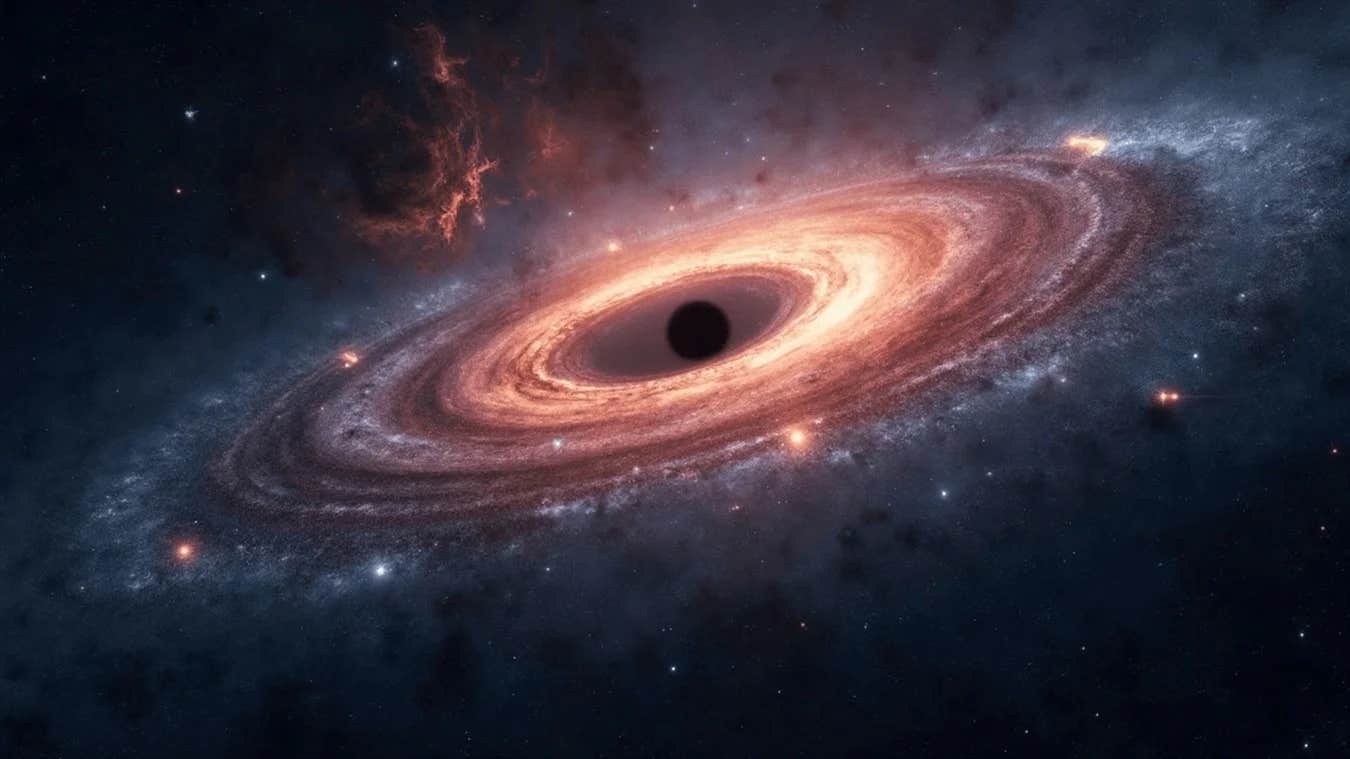Milky Way’s central black hole spins at nearly light speed, study finds
Using artificial intelligence and millions of simulations, scientists have discovered that the Milky Way’s black hole spins near its limit.

Sagittarius A*, the super massive black hole at the center of the Milky Way galaxy, has long been the subject of many astrophysical studies. (CREDIT: Tranding art/Shutterstock)
A new generation of black hole research is unfolding thanks to artificial intelligence, massive simulations, and cutting-edge computing. Scientists have used a powerful neural network trained with millions of synthetic images to uncover surprising new insights into Sagittarius A*, the black hole at the heart of the Milky Way.
This work, led by an international team of astronomers and supported by computing resources at the University of Wisconsin-Madison, has revealed that this black hole is spinning close to its theoretical maximum. The findings were published in Astronomy & Astrophysics.
Cracking Open Cosmic Mysteries
The Event Horizon Telescope (EHT) stunned the world in 2019 with the first image of a black hole, found in the M87 galaxy. Then in 2022, it released a new image of Sagittarius A*, our galaxy's central black hole. However, those images only scratched the surface. The data behind them was rich with signals that scientists couldn’t yet interpret.
To change that, the researchers built a library of nearly one million simulated black hole datasets. These datasets were created using general relativistic magnetohydrodynamics (GRMHD) simulations, which model how matter behaves under the intense gravity of a black hole. Each image was paired with variables like black hole spin, magnetic fields, and disk temperature.
The team trained a Bayesian neural network on these simulations to uncover patterns hidden in the EHT data. Unlike traditional machine learning models, Bayesian networks estimate uncertainty. That means they don't just make guesses—they also explain how confident they are in their results.
What they found was surprising: Sagittarius A* appears to be spinning very fast, and its axis is pointed nearly in Earth’s direction. This contradicts earlier theories about the orientation and magnetic structure of black holes.
"That we are defying the prevailing theory is of course exciting," said lead researcher Michael Janssen from Radboud University in the Netherlands. "However, I see our AI and machine learning approach primarily as a first step. Next, we will improve and extend the associated models and simulations."
Related Stories
Scaling Science With Supercharged Computing
At the core of this breakthrough was high-throughput computing (HTC). Unlike supercomputers that focus on a single large task, HTC breaks problems into thousands of smaller jobs. These are distributed across a vast network of computers. The Center for High Throughput Computing (CHTC), a joint effort by the Morgridge Institute for Research and the University of Wisconsin-Madison, has been refining this approach for decades.
HTC makes it possible to run millions of simulations that would otherwise be impossible with standard computing. Over three years, the EHT team ran more than 12 million jobs through this system, a process made seamless by software that automates data handling and scheduling.
"A workload that consists of millions of simulations is a perfect match for our throughput-oriented capabilities," said Miron Livny, director of CHTC. “We love to collaborate with researchers who challenge the scalability of our services.”
Professor Anthony Gitter, a Morgridge Investigator, added: “We are pleased to see EHT leveraging our throughput computing capabilities to bring the power of AI to their science.”
The computing power was further boosted by the Open Science Pool, which taps into resources from over 80 institutions across the U.S., all coordinated by the PATh (Partnership to Advance Throughput Computing) project.
Rebuilding the Telescope Data From the Ground Up
To get trustworthy results, the researchers also had to fix imperfections in the original EHT data. Upgrades to the data calibration pipeline, including new software and signal stabilization tools, helped reduce noise and improve sensitivity.
The team merged data from different frequency bands and polarizations, improving the clarity of the signals. By combining these, they managed to detect more subtle features in the black hole images than ever before.
Each dataset was compared against the simulations using forward modeling. This approach predicts what the telescope should see based on a theoretical model. By doing this hundreds of thousands of times, the researchers could rule out unrealistic models and zero in on ones that matched the real observations.
The result was a massive library of synthetic black hole data—932,000 simulated sets for Sagittarius A* and M87*. The simulations captured everything from telescope errors to atmospheric turbulence, creating mock data nearly identical to what the EHT would observe in real life.
A Spin on the Future
One of the most important findings from this work is the spin of Sagittarius A*. Black holes can spin at speeds close to the speed of light. This spin affects how they pull in matter and shoot out energy. The new results suggest our galaxy’s black hole is spinning at nearly the top possible speed.
And it doesn’t stop there. The study also found that the bright ring around the black hole—seen in the famous images—is mostly caused by hot electrons in the accretion disk, not by jets as previously thought. The magnetic fields around the black hole also appear to behave differently than expected.
These results were only possible because the neural network had access to so much simulated data. Traditional studies worked with only a few dozen synthetic images. This project used millions, giving the AI much more to learn from.
"The ability to scale up to the millions of synthetic data files required to train the model is an impressive achievement," said Chi-kwan Chan from the University of Arizona.
The effort required collaboration across fields: astronomers, computer scientists, and software engineers all played key roles. The goal now is to take the methods even further. Future versions of the EHT will include more telescopes, higher frequencies, and better resolution.
As the technology improves, the models will grow more accurate. AI will be trained on even richer datasets, and researchers expect to solve even deeper mysteries of space.
It’s a clear sign that artificial intelligence and big data are now essential tools in astronomy. With these technologies, researchers are no longer just taking pictures of black holes. They’re beginning to understand them.
Note: The article above provided above by The Brighter Side of News.
Like these kind of feel good stories? Get The Brighter Side of News' newsletter.



